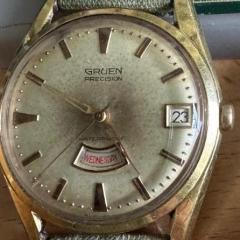Mainspring
-
Similar Content
-
Recently Browsing
- No registered users viewing this page.
-
Topics
-
Posts
-
Thank you. No value to me, and I guess not much value to anyone else either - just practice fodder as far as I see them. Ingersoll might make a nice watch to wear if I manage to service it. Benrus, I suspect, is too far gone in terms of case and dial - no cheap ways of getting them to decent looking condition? I wonder how these old movements compare to modern Chinese ones? Probably not favourably, even if there's nothing broken in them? Progress moves on? I've got an old Slava that I'm quite attached to, so I won't be learning on that one.
-
Welcome to the forum. You're best starting with something that you know runs well and keeps good time. That way when you've stripped and service it, any problems are due to something you've done.
-
Welcome to the WRT-Forum! Sorry to say it, but you’re very likely to break or lose something when servicing a wristwatch for the first time — I’ve been there! So, if these watches have any value to you, don’t attempt to service them as a beginner.
-
In writing "shimming the staff" I was alluding to the idea trailed in the above referenced thread of inserting a hair along the staff which, as the discussion there covered, could result in some eccentricity. By making a (more or less) complete cylinder I was hoping to avoid that problem. Don't tell anyone, but needing a very ductile metal to do this by manipulation at such a small scale, I used a piece of an empty Tomato pureé tube! It occurred to me that the material's ductility(?) would also put less stress on the RT in forming a sufficiently tight seal. Anyway, that's how I avoided the temptation to use glue. No doubt your punctuational response to this confession will be "!!!" !
-
Hi All. I would appreciate some advice for a complete newbie on getting into watch servicing - nothing serious, just as a fun project. I've got a thing for hand-wound watches and would like to bring an old watch (or two) back to life, so looking to learn to do a strip-clean-oil-assemble cycle. I've toyed with this idea in the past (years ago) and picked up a couple candidates to learn on, but never found the time for them. One is an old Ingersoll, swiss-made 17 jewels. It seems to wind and tick. Casing, dial, glass are in great shape, so looks like a good candidate to me for the first service. The other is a Benrus DR23. It winds and makes a few reluctant ticks, but then seems to stop. Casing looks like a complete gonner, and the dial is in pretty poor shape too. If the movement is not broken and just needs a service, I wonder if there's any possibility of getting a cheapo Chinese casing & dial to fit this movement in, or is it extremely unlikely to be the right size? For a start, I want to strip & assemble a movement, perhaps a dozen times to build up the basic parts handling skills. I see that online advice is to buy a Chinese-made ST36 for this purpose. Can I just go at the Benrus or Ingersoll instead, or does it make more sense to get a cheap ST for this? Thank you.
-





.thumb.jpg.cb17a66989f1e796fd4217db2e9ca9df.jpg)

Recommended Posts